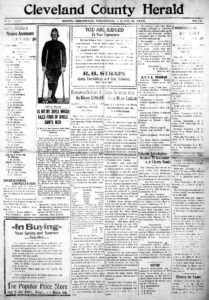calsfoundation@cals.org
Papers at Our Fingertips at the EOA and Beyond
Back in November I went back to the Arkansas State Archives for my first visit in more than a year, needing to access some railroad commission records, as well as a newspaper from 1933. I had spent a lot of time there in the early 2000s, when I was working on my dissertation on “racial cleansing,” or the expulsion of African Americans from various communities across Arkansas. Often, my research was predicated upon little more than census figures—so many people in one decade, compared with fewer the subsequent decade, numbers that spoke to the possibility of some act of violence. So, back then, with few options available to me, I just loaded a spool of the local newspaper on an available microfilm reader and spent hours and hours scrolling through the issues, hoping to find whatever event resulted in the exodus of the local Black population.
 Back then, newspaper digitizing was in its infancy, but it was on the horizon. The scanning technology was becoming better, and so, too, was the character recognition software. I knew that doing my dissertation at any point in the future would be a much easier affair—I wouldn’t need to sift through a decade of newspaper on microfilm, scanning with my own eyes each headline for a clue. With a few keywords and a date range, one day the information I sought would be right there. But I liked to imagine that the time I was spending was worth the trouble, not only for the completion of my dissertation, but also simply by its nature, the day-by-day drag allowing me to get a better sense of these communities than I might otherwise have.
Back then, newspaper digitizing was in its infancy, but it was on the horizon. The scanning technology was becoming better, and so, too, was the character recognition software. I knew that doing my dissertation at any point in the future would be a much easier affair—I wouldn’t need to sift through a decade of newspaper on microfilm, scanning with my own eyes each headline for a clue. With a few keywords and a date range, one day the information I sought would be right there. But I liked to imagine that the time I was spending was worth the trouble, not only for the completion of my dissertation, but also simply by its nature, the day-by-day drag allowing me to get a better sense of these communities than I might otherwise have.
Maybe it did. Yet I must confess that my own research has been greatly aided by the rise of newspaper digitization. Some years back, the Arkansas State Archives and the Central Arkansas Library System made an arrangement with Newspapers.com to provide microfilm of Arkansas newspapers in return for free access to patrons on site. This has been a boon to our work here at the CALS Encyclopedia of Arkansas. Fact checking has never been easier, and our media editor can procure clippings of newspaper stories to illustrate entries for which there are no other pieces of media. This access has also greatly advanced my own research. While looking up something else, I recently stumbled upon a racial conflagration in a region of Pulaski County known as Brushy Island. Thanks to the easy keyword searches provided on Newspapers.com, I was able to track down, with minimal effort, the history of Brushy Island and the public lives of the individuals involved in this conflict. Within an afternoon, I had pdf clippings of newspaper articles spanning some fifty years and was able to whip together a forthcoming piece for the Pulaski County Historical Review. Sure, there is something I probably missed, but that is more than balanced by the ability to do such a broad survey within a short amount of time.
Another important newspaper digitizing effort has been Chronicling America, a project of the Library of Congress, which has worked with local repositories to digitize state newspapers. For some years now, I have been on a committee that consults with the staff of the Arkansas State Archives to decide which newspapers to prioritize for digitization efforts, and the results to date, as chronicled in a recent Arkansas Democrat-Gazette article, are that more than 240,000 pages of historic Arkansas newspapers have been put online and made available to researchers, including some from before Arkansas’s statehood.
 Moreover, staff members at the Arkansas Digital Newspaper Project at the Arkansas State Archives have been, as they assemble the histories of the various newspapers they have been digitizing, adapting their research into entries for the Encyclopedia of Arkansas, such as Cleveland County Herald and more.
Moreover, staff members at the Arkansas Digital Newspaper Project at the Arkansas State Archives have been, as they assemble the histories of the various newspapers they have been digitizing, adapting their research into entries for the Encyclopedia of Arkansas, such as Cleveland County Herald and more.
I cannot stress just how much an impact this project of digitization has had on the development of Arkansas history, even if the full effect is not yet appreciated. One of my colleagues here at CALS, Mark Christ, became interested in steamboat disasters, and so, after finding a list of steamboats that went down in Arkansas waters, he turned to these digitized newspapers and has been able to write separate entries on each one (check out the chart on this entry), with approximately three dozen having been put online so far. The speed with which the history of our state can be written is simply unprecedented.
Back in November, I visited the Arkansas State Archives for the first time in more than a year. But that’s not quite accurate. Every day, it seems, I am using one of the digital resources made available by the Arkansas State Archives, as well as those by my own colleagues here at the CALS Roberts Library. These digital resources are a boon to the study of our state, and every day I use one of them, I am thankful that the access and technology—and my own attitudes—have progressed as much as they have.
By Guy Lancaster, editor of the CALS Encyclopedia of Arkansas



